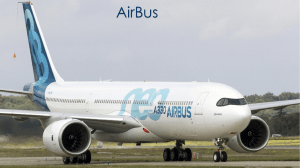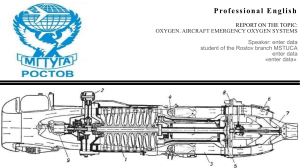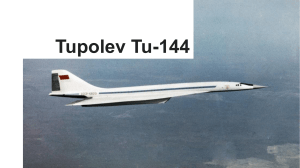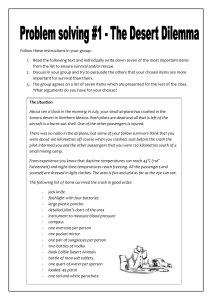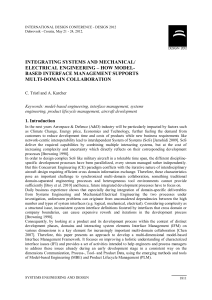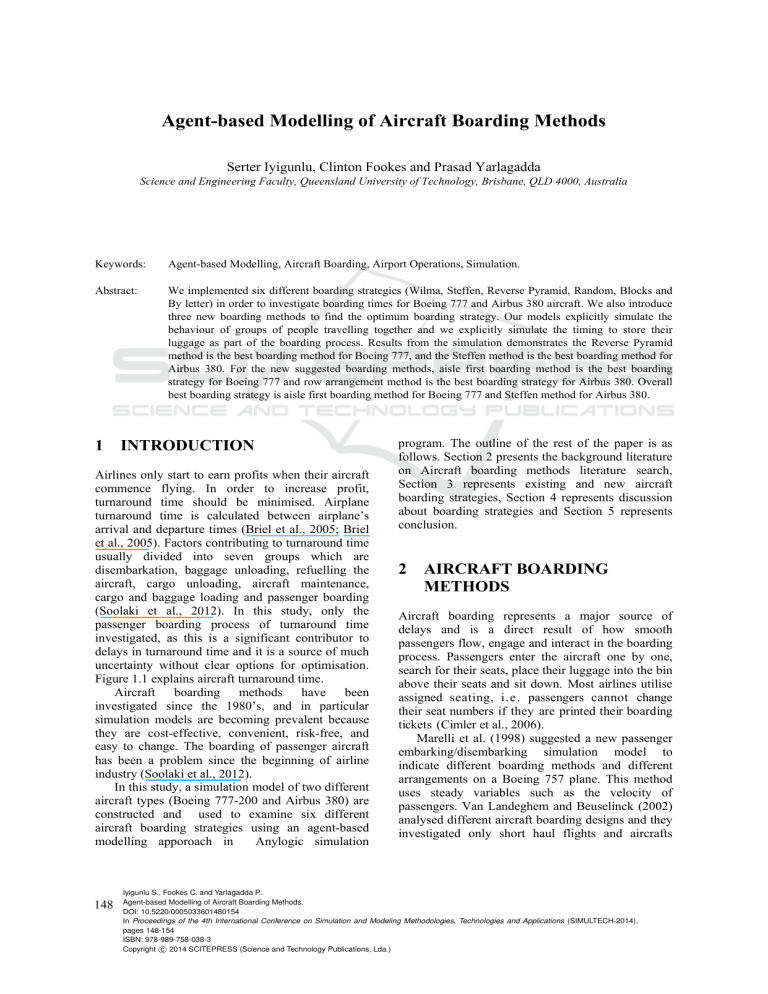
Agent-based Modelling of Aircraft Boarding Methods Serter Iyigunlu, Clinton Fookes and Prasad Yarlagadda Science and Engineering Faculty, Queensland University of Technology, Brisbane, QLD 4000, Australia Keywords: Agent-based Modelling, Aircraft Boarding, Airport Operations, Simulation. Abstract: We implemented six different boarding strategies (Wilma, Steffen, Reverse Pyramid, Random, Blocks and By letter) in order to investigate boarding times for Boeing 777 and Airbus 380 aircraft. We also introduce three new boarding methods to find the optimum boarding strategy. Our models explicitly simulate the behaviour of groups of people travelling together and we explicitly simulate the timing to store their luggage as part of the boarding process. Results from the simulation demonstrates the Reverse Pyramid method is the best boarding method for Boeing 777, and the Steffen method is the best boarding method for Airbus 380. For the new suggested boarding methods, aisle first boarding method is the best boarding strategy for Boeing 777 and row arrangement method is the best boarding strategy for Airbus 380. Overall best boarding strategy is aisle first boarding method for Boeing 777 and Steffen method for Airbus 380. 1 INTRODUCTION Airlines only start to earn profits when their aircraft commence flying. In order to increase profit, turnaround time should be minimised. Airplane turnaround time is calculated between airplane’s arrival and departure times (Briel et al., 2005; Briel et al., 2005). Factors contributing to turnaround time usually divided into seven groups which are disembarkation, baggage unloading, refuelling the aircraft, cargo unloading, aircraft maintenance, cargo and baggage loading and passenger boarding (Soolaki et al., 2012). In this study, only the passenger boarding process of turnaround time investigated, as this is a significant contributor to delays in turnaround time and it is a source of much uncertainty without clear options for optimisation. Figure 1.1 explains aircraft turnaround time. Aircraft boarding methods have been investigated since the 1980’s, and in particular simulation models are becoming prevalent because they are cost-effective, convenient, risk-free, and easy to change. The boarding of passenger aircraft has been a problem since the beginning of airline industry (Soolaki et al., 2012). In this study, a simulation model of two different aircraft types (Boeing 777-200 and Airbus 380) are constructed and used to examine six different aircraft boarding strategies using an agent-based modelling apporoach in Anylogic simulation 148 program. The outline of the rest of the paper is as follows. Section 2 presents the background literature on Aircraft boarding methods literature search, Section 3 represents existing and new aircraft boarding strategies, Section 4 represents discussion about boarding strategies and Section 5 represents conclusion. 2 AIRCRAFT BOARDING METHODS Aircraft boarding represents a major source of delays and is a direct result of how smooth passengers flow, engage and interact in the boarding process. Passengers enter the aircraft one by one, search for their seats, place their luggage into the bin above their seats and sit down. Most airlines utilise assigned seating, i.e. passengers cannot change their seat numbers if they are printed their boarding tickets (Cimler et al., 2006). Marelli et al. (1998) suggested a new passenger embarking/disembarking simulation model to indicate different boarding methods and different arrangements on a Boeing 757 plane. This method uses steady variables such as the velocity of passengers. Van Landeghem and Beuselinck (2002) analysed different aircraft boarding designs and they investigated only short haul flights and aircrafts Iyigunlu S., Fookes C. and Yarlagadda P.. Agent-based Modelling of Aircraft Boarding Methods. DOI: 10.5220/0005033601480154 In Proceedings of the 4th International Conference on Simulation and Modeling Methodologies, Technologies and Applications (SIMULTECH-2014), pages 148-154 ISBN: 978-989-758-038-3 Copyright c 2014 SCITEPRESS (Science and Technology Publications, Lda.) Agent-basedModellingofAircraftBoardingMethods Passenger missing Call for passengers Passengers leave plane (Deplane) 10-15 minutes Airplane turn time 30-60 minutes Transfer passengers' late arrival Aircraft cleaning 10-15 minutes Passenger boarding (Enplane) 10-30 minutes Card reader jammed Boarding pass control at gate entrance Handluggage retrieval at gate Handluggage storage insufficient Passenger installation in aircraft Seat assignment errors Seats occupies out of sequence Figure 2.1: Aircraft turnaround time explanation (Landeghem and Beuselinck, 2002). typically have 80 to 150 seats. Van den Briel et al. (2003, 2005) applied programming, noticed data and simulation to study the aircraft boarding strategy. Ferrari and Nagel (2006) used different arrangements to assess different aircraft boarding methods and suggested a new aircraft boarding method that contains boarding groups, it consists of different types of schemes such as early and/or late passenger but did not cover aisle interferences. Bazargan (2007) evaluated the meddling between the passengers that cause waiting during the boarding process and built a new integer programming model to reduce the interferences, the suggested system is good for reducing boarding time but it only includes single aisle aircraft types. Nyquist and McFadden (2008) demonstrated the cost-effective way to board passengers including carry-on luggage and boarding trough two doors. Steffen (2008) implemented the Markow Chain Monte Carlo algorithm and numerical simulation to research the aircraft boarding method in order to minimise boarding time. Steiner and Philipp (2009) sought some actions like introducing pre-boarding areas that can reduce the boarding time and turn time; they investigate only two different boarding strategies (Back to Front method and Random method). Tang et al. (2012) used the pedestrian flow theory to suggest an aircraft boarding method to research the random boarding strategy (Tang et al., 2012). The literature introduced different boarding strategies in order to reduce boarding time. These include: 1.) Wilma Method: Passengers seated at the windows boarding first, followed by the middle and aisle seats. Inside the group passengers are ordered randomly, therefore there are no seat interferences. 2.) Reverse Pyramid (back to front): passengers board from the rear rows first and then boarding gradually moves forward. 3.) Steffen method: Neighbouring passengers in line are sitting two rows apart from each other in equivalent seats. (e.g., 12A, 10A, 8A, 6A. etc.) 149 SIMULTECH2014-4thInternationalConferenceonSimulationandModelingMethodologies,Technologiesand Applications (Steffen and Hotchkiss, Experimental test of airplane boarding methods, 2012). 4.) Random method: All passengers are boarding together, without particular arrangement (Cimler et al., 2009). 5.) Blocks: Boarding in blocks. The back rows are first boarded, then the front blocks boarded and finishing with the centre rows blocks (Cimler et al., 2009). 6.) By letter: This is a special type of boarding method, in which each Class contains all seats with the same tag. (A to F) (H. Van Landeghem, 2002) Generally, the actual boarding process comprises three steps (Landeghem and Beuselinck, 2002): 1. The gate agent announced beginning of the boarding process. Passengers start queuing at the gate. There might be delay because of the late arrival passengers. (Call- Off System) 2. The gate agent checks the boarding pass of each passenger, and records their entry by using a ticket reader. This step in the procedure is the only moment we have control on who enters at what time. 3. Finally passengers enter the airplane through the bridge and the front door of the aircraft. There are two types of interferences in the boarding process. One of them is seat interference and the other one is aisle interferences (Briel et al., The Aircraft Boarding Problem, 2003). By minimizing the total expected number of seat and aisle interferences is the best way to minimize boarding time. Seat interference happens when the middle and/or aisle seat passenger boards earlier than a window or middle seat passenger that sits on the same side and row of the aircraft. For instance, a passenger is seated in seat 12C. When the passenger with seat 12B or 12A boards the aircraft, passenger 13C must leave their seat in order to give way to passenger 13B or 13A. In definition of aisle interference is once a passenger boarding the aircraft must wait for the passenger in front of them to go their seat and to stow their luggage before carrying on to their seat. Aisle interference can happen within one group, or between two ensuing groups (Briel et al., 2003). Figure 2.1 illustrates both seat and aisle interferences. 150 3A 3B 4A 4B 5A 5B 3C 3D 3E 3F 4D 4E 4F 5C 5D 5E 5F 4C 3A 3B 3C 3D 3E 3F 4A 4B 4C 4D 4E 4F 5A 5B 5C 5D 5E 5F 6C 6D 6E 6F 6A 6B Figure 2.2: Seat (above) and aisle (below) interferences illustration (Junior et al., 2008). 3 AGENT-BASED MODELLING Agent-based modelling offers a way to model social systems that are composed of agents who interact with influence each other. Agent-based modelling is a way to model the dynamics of complex systems and complex adaptive systems. The essential characteristic of an agent is the ability to make independent decisions (Macal and North, 2010). An agent should have the following characteristics: An agent is a self-contained, modular and uniquely identifiable individual. An agent is autonomous and self-directed. An agent has a state that varies over time. An agent is social having dynamic interactions with other agents that influence its behaviour (Macal and North, 2010). In addition to the above statements, the agent should have the following characteristics: An agent should be a reactive that responses to changes in its environment. An agent is a proactive. An agent should be adaptable and has many ways of obtaining targets (Ronald et al., 2007). Agent-basedModellingofAircraftBoardingMethods 4 AIRCRAFT TYPES AND IMPLEMANTATION OF BOARDING STRATEGIES In this study, Boeing 777 and Airbus A380 aircrafts were used because of their seat capacity and widely used for international travelling. Boeing 777 has two aisles, total 42 rows and its capacity is 313 passengers. Airbus 380 is consisted of two aisles, total of 48 rows and its capacity is 498 passengers. Airbus 380 is also a double-deck aircraft. 4.1 Boarding Strategies In practice most commercial airline companies use what is called a back-to-front boarding strategy. The idea is to free the aisle of congestions as much as possible (Audenaert et al., 2009). The back to front approach results in the bottleneck being created in a reduced area of the aisle between passengers of the same group to store their carry-on luggage and to reach their assigned seat in an appropriate way (Briel et al., The Aircraft Boarding Problem, 2003). The distribution of passengers travelling through the air transportation system includes those travelling for business purposes and those travelling for tourism and leisure. Business travellers predominantly travel alone; however, those travelling for tourism and leisure are regularly in groups. To reflect this reality in the simulation, all passengers are randomly drawn from a distribution of group sizes where the group size predominantly varies from one to five. In the arrival, passengers are assigned an attribute in order to determine their seats and behaviour in the group. Table 4.1: Passengers’ attributes represent baggage waiting time, golden passengers percentage, children percentage and group size. Simulation Attributes Baggage in flight Minimum 5 seconds, waiting time average 25 seconds and maximum 60 seconds Golden passengers 0.5 % probability Passengers with 1% child probability Group size Varying from 1 to 5 If a passenger has a luggage in flight, there is a delay in their row, which is minimum 5 second, average 25 seconds and maximum 60 seconds. Table 3.1 shows passengers’ attributes in the simulation program. In the beginning of the simulation, these attributes are applied to the passengers. Golden passengers are assigned at the rate of 0.5 % of all passengers. Child passengers are assigned according to the probability of 1 %. 1% of all passengers are children in the simulation program. Passengers Arrive at the gate Passengers Go to Waiting Area for Boarding First Boarding Group: Passengers with child Second Boarding Group: Group size of 5 people or more Third Boarding Group: Gold members Fourth Boarding Group: First Class Passengers Fifth Boarding Group: Business Class Passengers Economy Class Passengers are Boarded according to theri boarding zone Figure 4.1: Aircraft boarding simulation process. Table 4.2: Boarding times overall. Boarding Time(minutes) Wilma Method Boarding Standard Deviation Time(minutes) B777 A380 Passenger Number= 313 Passenger Number= 498 31.4487 2.041797686 55.598 1.943370897 Standard Deviation Reverse Pyramid (Back To Front) 29.6414 1.896140536 43.988 1.022474884 Steffen Method Random Method Blocks By Letter 40.3306 30.6855 35.0046 47.8871 1.518928365 2.40296924 2.009044449 2.058640946 39.4632 51.6033 48.6333 64.0214 1.296724489 1.209080188 1.474254467 2.793316873 Each boarding method was run ten times in order to investigate boarding methods. The reverse pyramid method is the fastest boarding method for the Boeing 777-200 as it can be seen in Table 3.2. The reverse pyramid method however is not the fastest boarding method for Airbus 380. It is because difference between aircraft lay outs. Airbus 380 is a two-level aircraft and its best efficient boarding method is the Steffen method. 4.2 Proposed New Boarding Methods In this section, the new boarding strategies will be investigating in order to reduce boarding times and turnaround time. The proposed new boarding methods are determined by testing all boarding 151 SIMULTECH2014-4thInternationalConferenceonSimulationandModelingMethodologies,Technologiesand Applications alternatives. The following figures show the new boarding strategies and aisle delays for each boarding strategy. Seat type 1 Seat type 2 Seat type 3 Figure 3.4 shows the row arrangement method. In this boarding method, passengers enter the aircraft according to their seat numbers. For example, row 12, row 15, row 18 etc., will be boarded first (Seat type1), row 13, row 16, row 19 etc., will be boarded second (Seat type2), row 14, row 17, row 20 etc., will be boarded third (Seat type3). Figure 3.5 shows aisle delay time for Boeing 777 and Airbus 380 aircrafts respectively for the row arrangement boarding method. Boeing 777 aisle delay time is slightly smaller than Airbus 380. Seat type 4 Figure 4.2: Aisle boarding first method illustrations. Seat type 1 enters the aircraft first, seat type 2 enters the aircraft second and seat type 3 enters the aircraft third. Figure 3.2 shows the aisle boarding first method. In this boarding method, all middle aisles of the aircraft are boarded first (Seat type1), following window seats (Seat type2), middle seats (Seat type2) and aisle passengers (Seat type3) are boarded respectively. Figure 4.5: Row arrangement method comparison of aisle delay times for two different aircraft types (Boeing 777 and Airbus 380). Figure 3.6 explains boarding method 3. Figure 4.3: Aisle boarding first method comparison of aisle delay times for two different aircraft types (Boeing 777 and Airbus 380). Figure 3.3 shows aisle delay times while boarding in the Boeing 777 and Airbus 380, respectively. X axis represents waiting times in minutes scale and Y axis represents the percentage of passengers. As seen in the graph, Boeing 777 aisle delay time is much smaller than Airbus 380 because of seat capacity. Seat type 1 Seat type 5 Seat type 2 Seat type 3 Seat type 6 Figure 4.6: Row blocks method illustrations. enters the aircraft first, seat type 2 enters second, seat type 3 enters the aircraft third, enters the aircraft fourth, seat type 5 enters fifth and seat type 6 enters the aircraft sixth. Seat type 1 Seat type 2 Seat type 3 Figure 4.4: Row arrangement method illustrations. Seat type 1 enters the aircraft first, seat type 2 enters the aircraft second and seat type 3 enter the aircraft third. 152 Seat type 4 Seat type 1 the aircraft seat type 4 the aircraft Figure 3.7 represents the comparison of aisle delay times for the Boeing 777 and Airbus 380 aircraft for the row blocks boarding method. As seen in the figure, Boeing 777 aisle delay time is much smaller than Airbus 380 delay time. On Airbus 380, aisle delay time is approaching 20 minutes but the average delay time is 11 minutes. Agent-basedModellingofAircraftBoardingMethods Table 5.1: Annual costs for each boarding method. Boarding time(minutes) Figure 4.7: Row blocks method comparison of aisle delay times for two different aircraft types (Boeing 777 and Airbus 380). Table 4.3: Boarding times overall. Boarding Time(minutes) Aisle boarding first method Row arrangement method Row blocks method Standard Deviation Boarding Time(minutes) Standard Deviation B777 A380 Passenger number=313 Passenger number=498 26.05 1.5510 46.66 1.3224 34.505 1.3243 42.773 1.3764 38.83 1.0909 61.627 1.4536 As seen in the Table 3.3, Aisle boarding first method is the fastest method for Boeing 777 but for Airbus 380 row arrangement method is given better boarding result. 5 DISCUSSION Boarding methods play a vital role in order to reduce the turnaround time and increase airlines’ efficiency. Airlines earn profit when their aircraft fly. In order to increase the number of flying aircraft each day, the turnaround time must be decreased. The turn time annual cost is found from the following expression (Nyquist & McFadden, 2008): 365 where; C: annual cost; B = average boarding time (in minutes); M = cost per minute on the ground; D = average number of daily flights. For example, if an airline spends $40 dollars on the ground per minute, and has 500 flights daily, Table 4.1 shows the annual costs for each boarding method. Aisle boarding first method Row arrangement method Row blocks method Annual cost for the Boeing 777 Boarding time (minutes) Annual Cost for the Airbus 380 B777 Passenger number=333 26.05 $190,165.00 0 A380 Passenger number=498 46.66 $340,618. 000 34.505 $251,886.50 0 42.773 $312,242. 900 38.83 $283,459.00 0 61.627 $449,877. 100 As seen in Table 4.1, reducing boarding times can play a significant role for airlines to make profit. For the Boeing 777 aircraft boarding methods, the difference between aisle boarding first method and row blocks method is $93,294.000. An airline can save $93,294.000 each year only by using aisle boarding first boarding strategy. 6 CONCLUSION In this study, we have implemented existing passenger boarding methods and three new boarding methods on Boeing 777 and Airbus 380 aircrafts. The reverse pyramid method is the fastest boarding method for Boeing 777 and Steffen boarding method is the fastest method for Airbus 380 out of the existing methods. Aisle boarding first method is the fastest boarding method for Boeing 777 because of the reduced aisle interferences and row arrangement method is the fastest boarding method for Airbus 380 due to increased smoothness of passenger flow. Aisle boarding first method is the fastest method for the Boeing 777 type of aircraft and Steffen boarding method is the fastest boarding method for Airbus 380 type of aircrafts. It is recommended that future research be undertaken in the following areas: 1. Investigate long haul flights Nowadays, international flights are playing important roles in airline industry. Future research should concentrate on long haul flights rather than short haul flights and investigate new type aircrafts for boarding methods such as Boeing 777 Dreamliner. 2. Investigate pre-boarding zones Future research should investigate pre-boarding zones and introduce boarding zone announcement system via mobile phones. Passengers should know where and when their boarding zones will be boarded. 153 SIMULTECH2014-4thInternationalConferenceonSimulationandModelingMethodologies,Technologiesand Applications REFERENCES Audenaert, J., Verbeeck, K., & Berghe, G. V. (2009). Multi-Agent Based Simulation for Boarding. The 21st Belgian-Netherlands Conference on Artificial Intelligence (pp. 3-10). Belgium: BNAIC. Bandini, S., Manzoni, S., & Vizzari, G. (2012). Agent Based Modeling and Simulation. Computer Science, 105-117. doi:10.1007/978-1-4614-1800-9_7 Bauer, D., Seer, S., & Brändle, N. (2007). Macroscopic Pedestrian Flow Simulation for Designing Crowd Control Measures in Public Transport after Special Events. SCSC 2007, (pp. 1035-1042). Bazargan, M. (2007). A linear programming approach for aircraft boarding strategy. European Journal of Operational Research, 394-411. Briel, M. H., Villalobos, J. R., & Hogg, G. L. (2003). The Aircraft Boarding Problem. In Proceedings of the 12th Industrial Engineering Reseach Conference(CDROM). IERC. Briel, M. H., Villalobos, J. R., Hogg, G. L., Lindemann, T., & Mule, A. V. (2005). America West Airlines Develops Efficient Boarding Strategies. ProQuest, 35, 191-201. Cimler, R., Kautzka, E., Olsevicova, K., & Gavalec, M. (2009). Agent-based model for comparison of aircraft boarding methods. Proceedings of 30th International Conference Mathematical Methods in Economics, (pp. 73-78). Ferrari, P., & Nagel, K. (2006). Robuttnes of Efficient Passenger Boarding Strategies for Airplane. Transportation Research Record:Journal of the Transportation Research Board, 44-54. Harney, D. (2002). Pedestrian modelling:Current methods and future directions. Road and Transport Research, 38-48. Junior, E. C., Silva, J. L., Briel, M. H., & Villalobos, J. R. (2008). Aircraft Boarding Fine-Tuning. XIV International Conference on Industrial Engineering and Operations Management. ICIEOM. Klügl, F., & Bazzan, A. L. (2012). Agent-Based Modeling and Simulation. AI Magazine, 29-40. Landeghem, H. V., & Beuselinck, A. (2002). Reducing passenger boarding time in airplane: A simulation based approach. European Journal of Operational Research, 294-308. Ma, W., Kleinschmidt, T., Fookes, C., & Yarlagadda, P. K. (2011). Check-in processing:Simulation of passengers with advanced traits. In S. Jain, R. R. Creasey, J. Himmelspach, K. P. White, & M. Fu (Ed.), Proceedings of the 2011 Winter Simulation Conference (pp. 1783-1794). IEEE. Macal, C. M., & North, M. J. (2010). Toward Teaching Agent-Based Simulation. Proceedings of the 2010 Winter Simulation Conference (pp. 268-277). Baltimore: IEEE. Marelli, S., Mattocks, G., & Merry, R. (1998). The Role of Computer Simulation in Reducing Airplane Turn Time. Aero Magazine. 154 Nyquist, D. C., & McFadden, K. L. (2008). A study of the airline boarding problem. Journal of Air Transport Management, 197-204. Papadimitriou, E., Yannis, G., & Golias, G. (2009). A critical assessment of pedestrian behaviour models. Transportation Research, 242-255. Qiu, F., & Hu, X. (2010). Modeling group structures in pedestrian crowd simulation. Simulation Modelling Practice and Theory, 190-205. Soolaki, M., Mahdavi, I., Mahdavi-Amiri, N., Hassanzadeh, R., & Aghajani, A. (2012). A new linear programming approach and genetic algorithm for solving airline boarding problem. Applied Mathematical Modelling, 4069-4072. Steffen, J. H. (2008). Optimal boarding method for airline passengers. Journal of Air Transportation Management, 146-150. Steffen, J. H., & Hotchkiss, J. (2012). Experimental test of airplane boarding methods. Journal of Air Transport Management, 64-67. Steiner, A., & Philipp, M. (2009). Speeding up the airplane boarding process by using pre-boarding areas. 9th Swiss Transport Research Conference (pp. 1-30). STRC. Tang, T., Huang, H., & Shang, H. (2012). A new pedestrian-following model for aircraft boarding and numerical tests. Nonlinear Dyn, 437-443.
